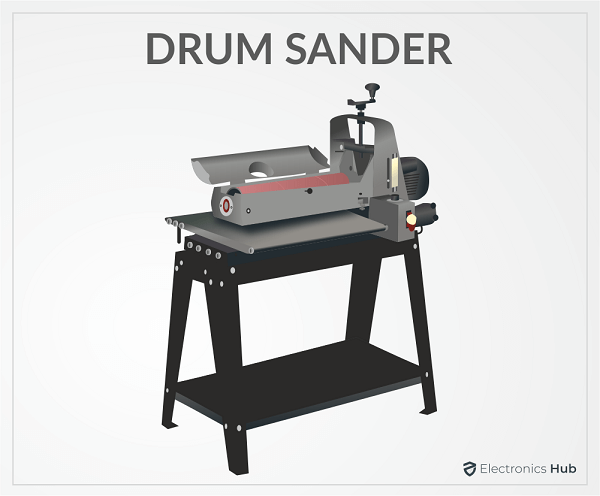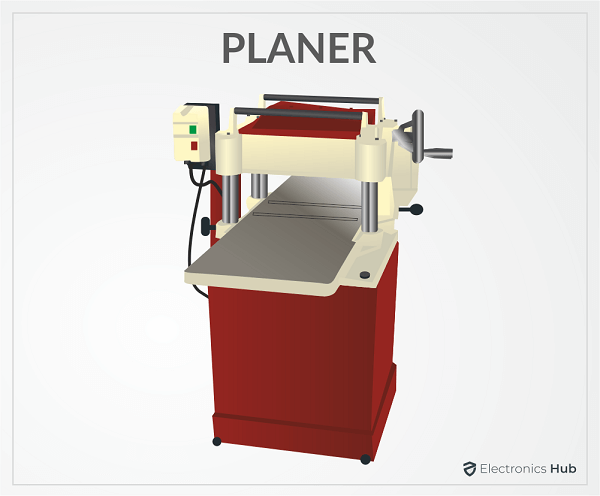Outline
ToggleWhat Is A Drum Sander?
A drum sander comes with a rotating sanding drum that lets you use it for standing down wood. It lets you use it for finishing projects. The tool can be ideal for shaving layers of wood and also while dealing with misshapen or warped wood.
For using it, you will have to add sandpaper to the machine. You can choose the grit according to the requirement as a low grit can provide abrasive sandpaper. It can sand according to the number of grit.
Pros and Cons of Drum Sander
Pros:
- Ability to give smooth and clean finishing.
- Comes with adjustable speed and height.
- Ideal for large projects.
- Ability to replace a planer.
Cons:
- It can burn wood if not handled properly.
- Replacement of the sandpaper can be tough.
- The sanding process can be longer.
- Expensive than a sander.
What Are The Main Features of Drum Sander?
- Adjustable Feed Rate: A drum sander comes with the feature of an adjustable feed rate. This lets you choose the work pace according to your requirement. It is a standard feature and can be great for making suitable adjustments.
- Load Sensing: Another great feature is that it comes with load sensing. By automatically slowing the input feed, it helps to prevent the burning of the motor as well as wood.
- Open VS Closed Drum: There are drum sander models that feature a closed-end. However, you will also find the drum sanders that come with an open end. This will give you the advantage of sanding materials with double width.
- Conveyor Adjustment: In a drum sander, you will find a course sandpaper conveyor. While used consistently, it may track off. Again, it does come with a conveyor adjustment system that allows adjusting the conveyor belts.
How Does Drum Sander Function?
A benchtop drum sander allows you to get into tight spaces and corners. There are many advantages of using a drum sander as it helps to prevent the marring of surfaces, particularly while working on carvings and furniture. This makes it ideal for working on wooden edges or furniture pieces.
You can easily use a drum sander on any type of wood. The functionality of a drum sander is bypassing the wood on the two rotating drums. The bottom drum rotates whereas the top drum is stationary. It is the bottom drum that helps to create a perfect finishing.
What Are The Safety Measures For Drum Sander?
One of the major safety concerns of using a drum sander is heat. When the machine is not handled properly, the likelihood of burning the wood as well as the machine is very high. For this reason, it is important to wear safety gloves. Users must wait for the machine to cool down before they intend to replace the sandpaper.
Another important factor to consider is the speed of the drum sander. As it runs at a high speed, users must be careful and not wear any loose clothing. There can also be chances of hurting the fingers. Users must always wear protective gear as well as a dust mask to prevent respiratory disorders.
What Is A Planer?
A planer is another tool that helps to remove the wood’s layers of thickness. It comes with a blade that can cut at high speed. Using a planer makes sure there will be a clean and even cut. You can find planers in different sizes so that you can use them according to your project.
Hand planers can be perfect for small projects and large projects, you can go for large-sized ones. With a planer, your woodworking task will be easier. It also comes with adjustable speed and lets you have the desired depth.
Pros and Cons of Planer
Pros:
- Fast cutting of wood.
- Suitable for all types of wood.
- Allow adjusting the cutting depth.
- Easy to use.
- Perfect for rough lumber dimension.
Cons:
- Unable to remove defects from wood.
- It is only limited to boards with narrow widths.
- Can make a loud noise.
- Blade sharpening can be tough.
- If not used properly, it can chop wood.
What Are The Main Features of Wood Planer?
- Adjustable feed rate:The greatest feature of a wood planer is that it comes with an adjustable feet rate. By adjusting the feed rate, you can prevent the damaging to the wood.
- Spiral head:For improving the quality of the planer, it comes with a spiral head. This makes it removes more silver from the wood at a time.
- Maximum width:In a planer, you can use boards with widths ranging from 13 to 20 inches. However, it can cost you more if you go for a wide-width size planer.
- Motor size: A motor with battery durability will be an ideal consideration. It can be great for consistent operation as well as professional purposes.
- Dust collection:With a dust collection system, there will be better health and a clean environment.
How Does Planer Function?
A planer comes in a versatile design that makes it ideal for different projects. Whether it is molding thicker stock or dealing with furniture pieces, you can have all. Another great advantage is that it is less noisy. You can easily use it for removing low and high areas and having the right thickness.
A planar comes with a table that has a cutting blade on the top. It is this plate that makes up and down motion. The cutter head attaches to the lower end of the edge. You can even adjust the height. The machine removes the excess wood while moving down from the top and provides a perfect surface.
What Are The Safety Measures for Planer?
While dealing with any tool, users need to be very careful. A planer comes with blades that make it cut wood. Make sure that you use appropriate safety precautions and prevent body parts as well as loose clothing. As it runs fast, you will have to use it carefully. Make sure that the wood that you are using is free from screws, nails, or staples. You must also use appropriate ear protection as it can be very loud.
Planer vs Drum Sander Comparison Table
| Planer | Drum Sander | |
| Type | Wood milling machine | Wood sander |
| Power | 15A motor | Heavy duty power |
| Speed | 30,000 cuts in a minute | Adjustable |
| Purpose | Reducing thickness,
shaving material |
Reducing thickness,
smoothening surface, sanding wood |
| Functions | Cutting old wood for new pieces | Surfacing and finishing tool |
| Safety | Relatively safe | Needs caution |
| Cost | Affordable | Expensive |
How Is Drum Sander Different From Planer?
A drum sander is used for reducing the thickness of lumber or wood stock. You can even use it for sanding the plane surface for having a smooth finish. The woodworking tool comes with a horizontal drum that is covered in sandpaper. The drum sanding machine features a manual feed or has an automated feed.
It forces the lumber through the channel for holding the lumber whereas the lumber feeds the drum. The side of the lumber facing the roller is sanded smooth. A planer is for milling down lumber. A drum sander and a planer are two completely different tools.
The main purpose of using a bench planer is for milling wood. Although it has a similar operation to that of a drum sander, it features a cutter head or a spindle. When the cutter head rotates, it is the blade that will shape the wood into pieces. Often called a thicknesser, a bench planer lets you carve the wood to have the desired thickness.
Drum Sander Vs Planer – FAQs
Ans: Drum sanders are typically used for sanding and finishing wood surfaces, while planers are designed to reduce the thickness of lumber and create uniform thickness throughout.
Ans: Drum sanders are generally better for achieving a smooth finish on wood surfaces, as they are specifically designed for sanding and polishing.
Ans: Drum sanders are ideal for projects that require a smooth and polished finish, such as furniture making, cabinetry, and finishing surfaces like tabletops.
Ans: Planers are preferable when the primary goal is to achieve a consistent thickness across the entire length of a board or when preparing rough lumber for further processing.
Ans: Always wear appropriate safety gear, such as safety glasses and hearing protection. Follow the manufacturer’s guidelines for each tool, ensure proper dust collection, and keep hands and clothing away from moving parts. Always disconnect power before changing blades or making adjustments.
Conclusion
We have seen the similarities and differences between a bench planer and a drum sander. As both the tools are used for having an even depth and leveling wood, there lies a huge difference. You should know your purpose as a planer is for cutting wood and a drum sander is for sanding. You can use a planer for creating a different depth of the wood. A drum sander can be great for making smooth and fine finishes.



